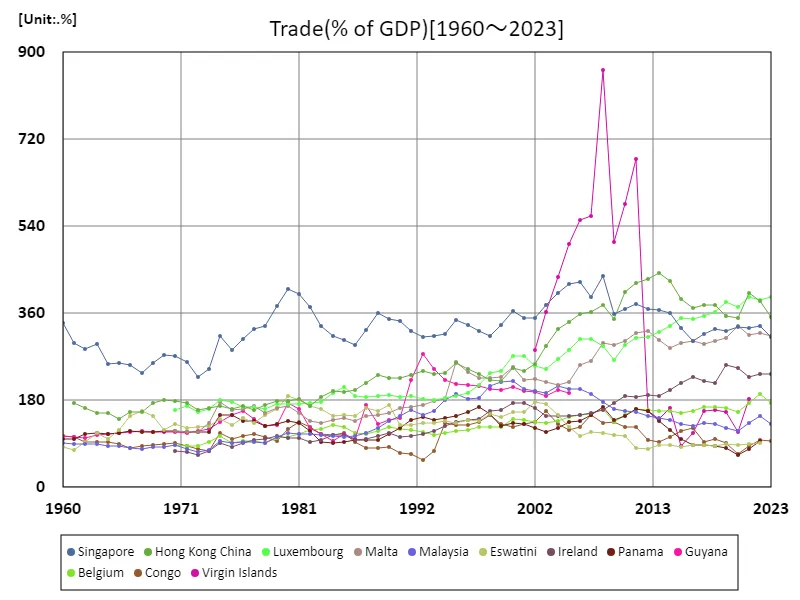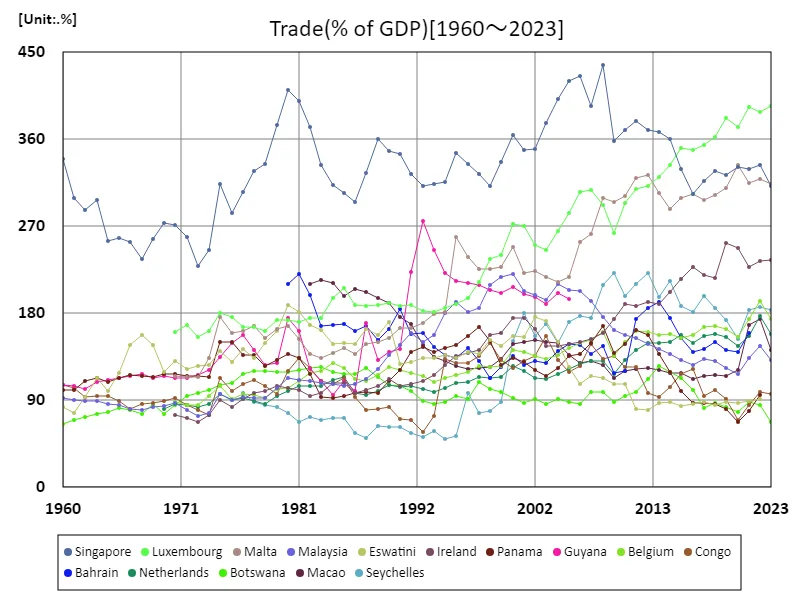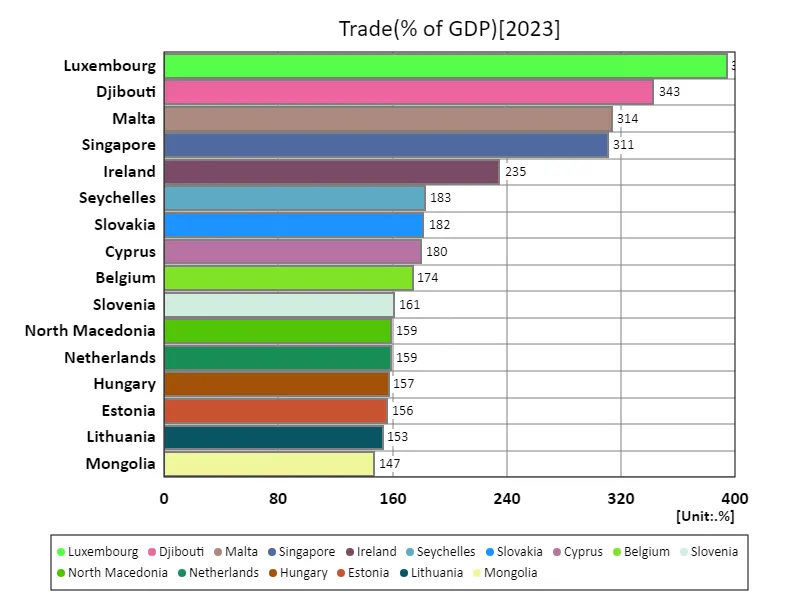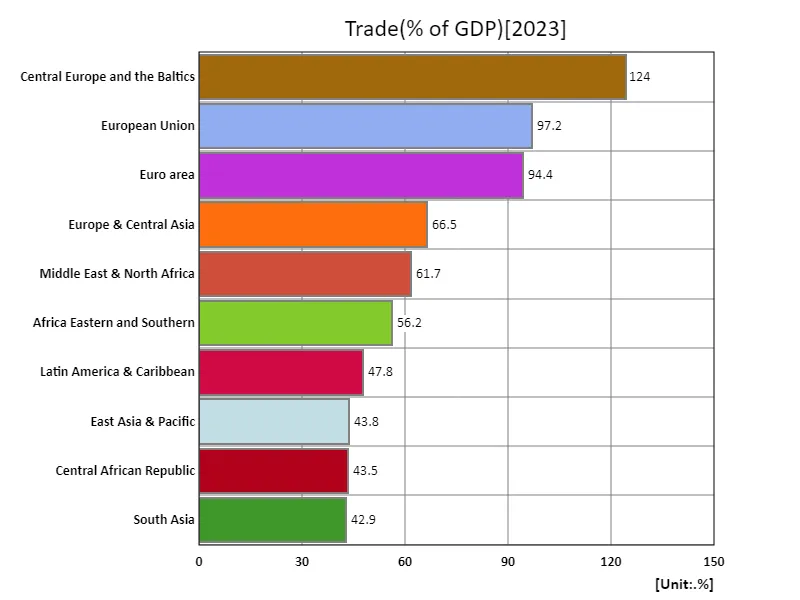Abstract
Total services trade (as a percentage of GDP) is an important indicator of the scale of international trade in services within a country’s economy. According to 2023 data, Luxembourg records the highest value in this indicator with 312%. This high ratio reflects Luxembourg’s unique economic structure. Luxembourg has a thriving service industry, including finance and insurance, and its role as an international financial center is particularly prominent. In addition, they tend to offer many services abroad to complement their small domestic market. A recent trend has been a shift from manufacturing to the core of the economy towards trade in services. The importance of trade in services is increasing, with the service sector now accounting for a large portion of GDP, especially in developed countries. In particular, in areas such as finance, IT, and tourism, international competitiveness is strengthening and the ratio of total trade in services to GDP is increasing. On the other hand, in countries with larger economies, services trade as a percentage of GDP tends to be relatively low. This is due to the large domestic market and low dependency on services exports. As such, the ratio of services trade to GDP varies greatly depending on a country’s economic structure and international role.
Total services trade (percent of GDP)
Data on total trade in services (% of GDP) from 1960 to 2023 reflects the changing role of services in international trade. In 2021, Luxembourg achieved a peak of 327%, but by 2023 this had fallen to 95.5%. Luxembourg’s high ratio reflects the country’s unique economic structure, in particular the large role played by the financial services and insurance industries. Overall, services trade as a percentage of GDP tends to be significantly higher in developed countries. This is due to the ongoing shift from manufacturing to services. In particular, international trade is active in industries such as finance, IT, and tourism, which is promoting the expansion of trade in services. On the other hand, there are also cases such as Luxembourg where the number has declined significantly since its peak. This is thought to be due to structural changes in the economy and fluctuations in the international competitive environment. As economic globalization progresses, trade in services continues to play an important role, but it is characterized by large fluctuations depending on the circumstances of each country.


The maximum is 863%[2008] of Virgin Islands, and the current value is about 21.2%
Total trade in services (percent of GDP) (nations around the world)
Looking back at the data on total trade in services (as a percentage of GDP) from 1960 to 2023, we can see that the role of international trade in services has expanded significantly. In particular, Luxembourg recorded a high level of 327% in 2021, but this declined to 95.5% in 2023. This fluctuation signals a change in Luxembourg’s economic structure and its role as an international financial centre. Overall, the ratio of services trade to GDP tends to be higher in developed countries, where the importance of the service industry is increasing. As the shift from manufacturing to the service sector progresses, services such as finance, insurance, IT, and tourism in particular have become at the center of international trade, contributing to an increase in their share of GDP. However, there are also examples, such as Luxembourg, where numbers have fallen significantly from their peak. This may be due to factors such as economic maturity, global competition, and even policy changes. The data shows how services trade is evolving in the international economy and shows that it varies significantly depending on each country’s economic structure and policies.


The maximum is 437%[2008] of Singapore, and the current value is about 71.2%
Total trade in services (percent of GDP) (nations around the world, latest year)
The data for total services trade (as a percentage of GDP) for 2023 highlights the importance of the services sector in the global economy. Luxembourg recorded an extremely high ratio of 312%, reflecting the country’s function as an international financial centre and its large export of financial services. On the other hand, the average is 31.5%, showing that extreme figures such as those in Luxembourg affect the overall trend. The overall total value is 3.56k%, indicating that trade in services accounts for a large proportion of each country’s economy. In particular, the service industry accounts for a large proportion of the economy in developed countries and contributes greatly to economic growth. In recent years, with the advancement of digitalization and globalization, service sectors such as IT, finance, insurance, and tourism are playing an important role in international trade. This data shows that the ratio of services trade to GDP varies greatly from country to country, with developed countries showing high ratios and developing countries showing relatively low ratios. It can be said that this indicator reflects changes in economic structure and the influence of the international economic environment.


The maximum is 394% of Luxembourg, the average is 93.8%, and the total is 12.6k%
Total trade in services (% of GDP) (region, latest year)
Total services trade (% of GDP) data for 2023 will highlight the importance of international trade in global services. The European Union’s high ratio of 29.8% reflects its economic integration within the EU and its strong international trade in services. The EU has a common market and provides many international financial, insurance and IT services, which contribute to the high ratio. With the overall average being 16.5%, we can see that developed countries and economically strong regions tend to have a relatively high ratio of services trade to GDP. This is due to the ongoing shift from manufacturing to services. On the other hand, the total value of 132% indicates that trade in services overall has a significant presence in the world economy. In other words, the service industry has become the center of international trade and has a major impact on the economic activity of each country. A trend to date is that, due to the advancement of globalization and digitalization, services trade is playing an important role instead of manufacturing trade, and its proportion is increasing, especially in developed countries. Conversely, developing countries tend to have a lower proportion of trade in services. These changes can be said to reflect structural shifts in the global economy.


The maximum is 124% of Central Europe and the Baltics, the average is 67.9%, and the total is 679%



Comments